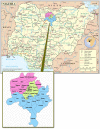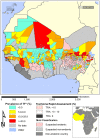Prevalence of and risk factors for trachoma in Kano state, Nigeria
- PMID: 22792311
- PMCID: PMC3391244
- DOI: 10.1371/journal.pone.0040421
Prevalence of and risk factors for trachoma in Kano state, Nigeria
Abstract
Background: In northern Nigeria, trachoma is an important public health problem, but there are currently few population-based data on prevalence of disease and no formal trachoma control programs.
Methodology/principal findings: In Kano state, Nigeria, we conducted a population-based cross-sectional survey using multistage cluster random sampling, combining examination for clinical signs of trachoma and application of questionnaires assessing potential household-level risk factors. A total of 4491 people were examined in 40 clusters, of whom 1572 were aged 1-9 years, and 2407 (53.6%) were female. In 1-9 year-olds, the prevalence of trachomatous inflammation-follicular (TF) was 17.5% (95% CI: 15.7-19.5%). In a multivariate model, independent risk factors for active trachoma were the presence of flies on the face (OR 1.98, 95% CI 1.30-3.02); a dirty face (OR 2.45, 95% CI 1.85-3.25) and presence of animal dung within the compound of residence (OR 3.46, 95% CI 1.62-7.41). The prevalence of trachomatous trichiasis in persons aged ≥15 years was 10.9% (95% CI: 9.7-12.2%). Trichiasis was significantly more common in adult females than in adult males.
Conclusion/significance: There is an urgent need for a trachoma control program in Kano state, with emphasis given to provision of good quality trichiasis surgery. Particular effort will need to be made to identify women with trichiasis and engage them with appropriate services while also taking steps to secure azithromycin for mass treatment and ensuring personal and environmental hygiene.
Conflict of interest statement
Figures
Similar articles
-
Prevalence of Trachoma in Kano State, Nigeria: Results of 44 Local Government Area-Level Surveys.Ophthalmic Epidemiol. 2017 Jun;24(3):195-203. doi: 10.1080/09286586.2016.1265657. Epub 2017 Feb 28. Ophthalmic Epidemiol. 2017. PMID: 28276755 Free PMC article.
-
Prevalence of Trachoma in Bauchi State, Nigeria: Results of 20 Local Government Area-Level Surveys.Ophthalmic Epidemiol. 2016;23(sup1):39-45. doi: 10.1080/09286586.2016.1238945. Epub 2016 Nov 15. Ophthalmic Epidemiol. 2016. PMID: 27846369 Free PMC article.
-
Prevalence of Trachoma in Katsina State, Nigeria: Results of 34 District-Level Surveys.Ophthalmic Epidemiol. 2016;23(sup1):55-62. doi: 10.1080/09286586.2016.1236975. Epub 2016 Oct 24. Ophthalmic Epidemiol. 2016. PMID: 27775463 Free PMC article.
-
Population-based prevalence survey of follicular trachoma and trachomatous trichiasis in the Casamance region of Senegal.BMC Public Health. 2017 Jul 26;18(1):62. doi: 10.1186/s12889-017-4605-0. BMC Public Health. 2017. PMID: 28747198 Free PMC article.
-
Prevalence of trachoma in 13 Local Government Areas of Taraba State, Nigeria.Ophthalmic Epidemiol. 2018 Dec;25(sup1):18-24. doi: 10.1080/09286586.2017.1368670. Ophthalmic Epidemiol. 2018. PMID: 30806533 Free PMC article.
Cited by
-
Will the SAFE strategy be sufficient to eliminate trachoma by 2020? Puzzlements and possible solutions.ScientificWorldJournal. 2013 May 19;2013:648106. doi: 10.1155/2013/648106. Print 2013. ScientificWorldJournal. 2013. PMID: 23766701 Free PMC article. Review.
-
Prevalence and associated factors of active trachoma among children aged 1-9 years old in mass drug administration graduated and non-graduated districts in Northwest Amhara region, Ethiopia: A comparative cross-sectional study.PLoS One. 2020 Dec 15;15(12):e0243863. doi: 10.1371/journal.pone.0243863. eCollection 2020. PLoS One. 2020. PMID: 33320864 Free PMC article.
-
Exposure to Animal Feces and Human Health: A Systematic Review and Proposed Research Priorities.Environ Sci Technol. 2017 Oct 17;51(20):11537-11552. doi: 10.1021/acs.est.7b02811. Epub 2017 Oct 9. Environ Sci Technol. 2017. PMID: 28926696 Free PMC article.
-
Prevalence of Trachoma in Benishangul Gumuz Region, Ethiopia: Results of Seven Population-Based Surveys from the Global Trachoma Mapping Project.Ophthalmic Epidemiol. 2016;23(sup1):70-76. doi: 10.1080/09286586.2016.1247877. Epub 2016 Dec 5. Ophthalmic Epidemiol. 2016. PMID: 27918248 Free PMC article.
-
Low Prevalence of Conjunctival Infection with Chlamydia trachomatis in a Treatment-Naïve Trachoma-Endemic Region of the Solomon Islands.PLoS Negl Trop Dis. 2016 Sep 7;10(9):e0004863. doi: 10.1371/journal.pntd.0004863. eCollection 2016 Sep. PLoS Negl Trop Dis. 2016. PMID: 27603015 Free PMC article.
References
-
- Mabey DC, Solomon AW, Foster A. Trachoma. Lancet. 2003;362:223–229. - PubMed
-
- World Health Assembly. Global elimination of blinding trachoma. 51st World Health Assembly, Geneva, 16 May 1998, Resolution WHA51.11. 1998.
-
- Abdu L. Prevalence and causes of blindness and low vision in Dambatta local government area, Kano State, Nigeria. Niger J Med. 2002;11:108–112. - PubMed
Publication types
MeSH terms
Grants and funding
LinkOut - more resources
Full Text Sources
Miscellaneous



